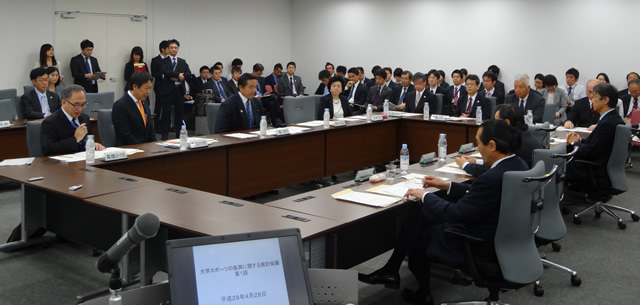Japanese collegiate sports study ends Phase 1
The Japan Times by Kaz Nagatsuka Apr 2, 2017

Japan is currently working to reform college sports and establish its own version of the National Collegiate Athletic Association (NCAA), creating athletic departments at universities to help it function more efficientlyrnWhen that’s accomplished, the hope is that it will benefit universities as a whole, enhance the experience of the students and bring communities together, using athletic programs as the catalystrnA joint research project between Japan’s University of Tsukuba, the United States’ Temple University and Dome Corporation (the licensed Japanese distributor for American sporting product company Under Armour) has carried out in-depth studies of the NCAA, which oversees college sports in the U.S., and athletic departments around the country, since last summer in order to provide reference points to create the best-possible environment for collegiate sports in JapanrnThe project gave a mid-term report in Tokyo last December. Jeremy Jordan, one of the project leaders, emphasized that the research is not intended to simply copy the U.S. modelrn“The goal of this Temple research group is to not take college athletics of the U.S. and plug it in for the Japanese system,” Jordan, director of the sport industry research center and an associate professor at Temple University, said during another report meeting in Tokyo last week. “It’s to take what really works well in the U.S. and use that as the foundation and create something new that makes sense and works for Japan.rnThere are certainly significant differences between college athetics Japan and the U.S. that cannot be overlookedrnThe education ministry and Japan Sports Agency want college athletics to generate revenue through games and tournaments, as no Japanese college sport has the type of lucrative TV deals seen in the U.S., mainly for men’s basketball and footballrnHowever, Daniel Funk, director of research and PhD programs and a professor at Temple, said that Japan doesn’t necessarily have to emulate the top athletic division of America, but should seek a well-balanced, harmonious point between “student-athletes and monetization” and “university and sport entertainment.rn“Division I, maybe that’s too commercial,” said Funk, who is another leader of the project. “Maybe Division II is the way to go, (maybe) Division III has the closer model. It’s more student-oriented, they are highly competitive.rnThe project said that the athletic programs of major Division I schools earn revenue by relying on TV rights and ticket sales. Athletic programs in Division II and III make the majority of their revenue from internal earnings such as student fees, university funds and government subsidiesrnCollegiate teams at Japanese universities operate like private organizations and run their programs with funds from the student-athletes and donations. But Yuhei Inoue, a project member and assistant professor of Sports Management at the University of Minnesota, insists that the financial structure has to change, making sports teams more attractive properties for their respective institutions to invest in. According to the project’s report, of the 1,123 NCAA schools, only 24 universities were in the black with net profits from athletics as of 2015. Universities in the States in general consider their athletic programs as part of the school brand, which develops a sense of belonging for current students, prospective students and alumni, and forms a bond with local communitiesrnInoue feels that Japanese college sports have the potential to create more financial resources with the right schemesrnHe cited the Hakone Ekiden, a traditional New Year relay marathon race which is by far the most popular collegiate sporting event in Japan. Hakone draws TV ratings somewhere between 20 and 30 percent whereas the NCAA men’s Final Four, considered the largest collegiate sporting event in the U.S., gets something around 10 percentrn“But we don’t have the NCAA (in Japan), and the athletics bodies (the Inter-University Athletic Union of Kanto, in Hakone’s case) don’t have the power to negotiate (with the broadcasting sides).rnThe government recently announced that it would form a “Japanese NCAA” before the end of the 2018 fiscal yearrnThere have been new moves elsewhere as well. Kyoto University’s football program became an incorporated organization last year so it could try to earn funds on its own, such as through selling tickets and getting endorsements. Waseda University has had an athletic department and teamed up with domestic sporting manufacturer Asics to obtain funds for its athletic programs through Asics’ custom-made Waseda merchandisernThe project has finished the first phase of its research, which was to understand the present circumstances of college sports in the U.S. This month, it will begin the next phase, where it will explore how athletic departments would function in Japan



